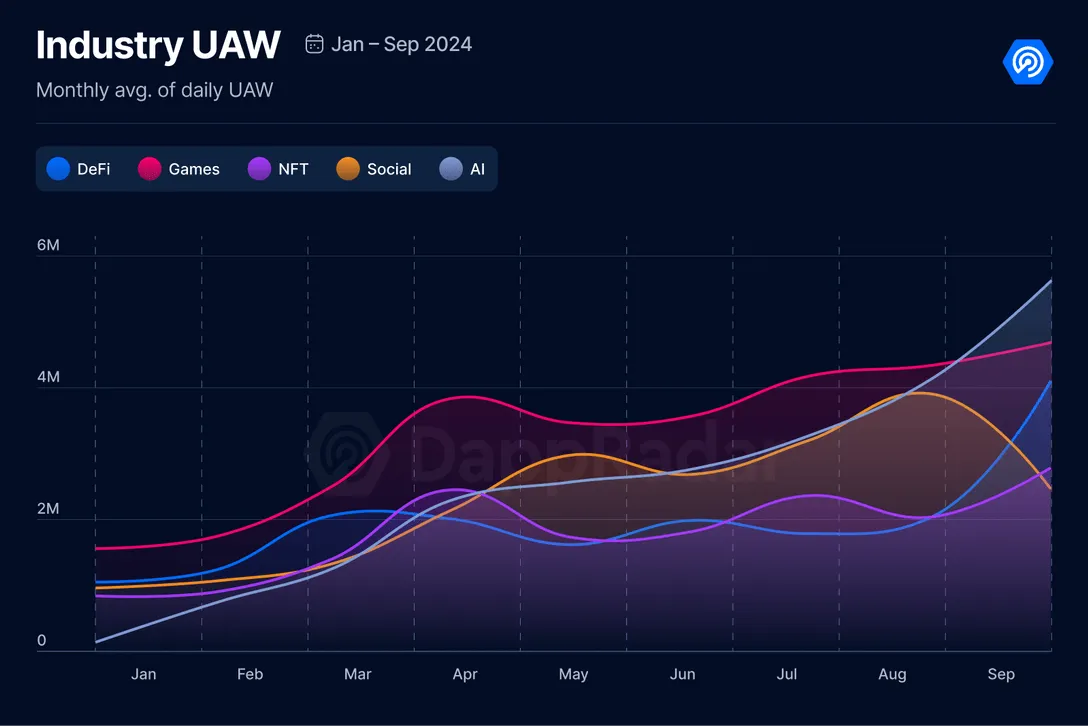Web3 gaming continues to expand at a fast pace. According to the 2024 DappRadar Games Report, the industry reached 7.4 million daily active wallets and launched more than 1,600 new games in a single year. Total gaming activity nearly quintupled compared to the end of 2023. While these figures highlight a strong influx of users and development activity, they also underscore a growing challenge: long-term player retention.
Web3 Sees Growth, But Lacks Retention
Despite the increase in user numbers and new projects, many games still lack robust loyalty systems. In most cases, loyalty mechanics feel secondary or entirely absent. As the gaming environment becomes more social, cross-platform, and community-driven, the need for effective loyalty systems is becoming increasingly important. Games that fail to offer compelling ways for players to stay engaged risk losing ground, even in a growing market.

DappRadar Games Report 2024
Limitations of Traditional Loyalty Models
In many gaming ecosystems, loyalty programs remain simplistic, often taking the form of basic point systems, leaderboards, or daily login rewards. These approaches do not align with how players engage today. Mistplay’s 2024 Mobile Gaming Spender Report found that 79 percent of mobile spenders interact with loyalty programs, and over half said they would spend more if the rewards offered greater value. This indicates a strong demand for deeper, more meaningful engagement.
Players increasingly view progression and recognition of their time and contributions as more motivating than short-term perks. Research from Boston Consulting Group supports this, showing that participatory loyalty models tend to enhance ongoing engagement. However, many games still rely on static incentives that do not adapt to player behavior or expectations.
This disconnect is further highlighted by consumer research from Attest, which revealed that a majority of younger gamers value cross-platform play and are resistant to intrusive advertising. These insights suggest that loyalty systems need to be integrated, flexible, and community-aware to be effective in today’s market.

Mistplay’s 2024 Mobile Gaming Spender Report
Emergence of Web3-Native Loyalty Solutions
A number of web3 gaming platforms are beginning to address this gap by introducing on-chain loyalty systems. These models focus on composable rewards and wallet-native ownership, allowing players to carry achievements and incentives across games and ecosystems. This shift reflects a broader trend toward more persistent and portable digital experiences.
Decentraland’s Marketplace Credits program is one example of this new approach. It offers users credits for activities such as exploring the world, attending events, and engaging with the platform. These credits can be exchanged for virtual goods like wearables and emotes, turning everyday participation into a structured engagement loop.

Decentraland Introduces Marketplace Credits
Mastercard’s Gamer Exchange and More
Beyond gaming platforms, established companies are also experimenting with web3-based loyalty systems. Mastercard’s Gamer Exchange allows users to convert existing loyalty points from banks, airlines, and retailers into in-game currency. This model demonstrates that the loyalty space is becoming a strategic priority, not only for gaming companies but also for major consumer brands.
Infrastructure providers are also playing a role in this evolution. Mojito Loyalty, for instance, offers tools that allow gaming projects to integrate on-chain quests, community rewards, and progression mechanics directly into digital environments. Meanwhile, games like Forgotten Runiverse and Pixels are using loyalty programs to support player economies that extend beyond single-game sessions, emphasizing continuous contribution and community involvement.
Forgotten Runiverse and Pixels
Loyalty is a Core Component of Player Retention
The industry’s focus is shifting from rapid growth to sustainable engagement. In 2024, over 12,000 gaming jobs were cut as studios faced rising development costs and diminishing returns on traditional user acquisition strategies. In response, many companies are turning to loyalty models, battle passes, and live service features to drive long-term engagement.
Traditional loyalty tools are not well suited for this shift. Static rewards and limited progression systems no longer meet the expectations of players who interact with games in social, creative, and cross-platform ways. On-chain loyalty programs, in contrast, offer a more adaptable framework. They can reward players not just for in-game activity, but also for contributions such as attending virtual events, creating content, or building communities.
According to John Wright, VP of Mobile Publishing at Kwalee, the goal is no longer limited to improving short-term retention metrics. Developers are now aiming to build loyalty systems that bring players back over months or even years. This broader vision requires tools that recognize and reward a wide range of player actions in ways that are transparent, portable, and meaningful.

Game Industry Layoffs Surge: 14,600 Jobs Lost in 2024
Final Thoughts
As gaming ecosystems move toward open economies and cross-platform identities, loyalty programs are becoming a foundational element rather than an optional feature. The ability to track, reward, and carry over player achievements across multiple experiences is aligning well with the decentralized nature of web3.
When loyalty systems are built on-chain and integrated into the core player experience, they create a consistent and rewarding environment that strengthens community bonds. This approach not only supports retention but also enables new forms of player expression and participation. In this context, loyalty is evolving from a marketing tool into a central mechanism for building long-term value in gaming communities.
Web3-native loyalty programs are no longer just experimental features. They are emerging as a critical part of the gaming stack, enabling developers to meet modern expectations for recognition, ownership, and community engagement. As the industry continues to mature, loyalty is likely to become one of the defining features of successful web3 gaming platforms.


